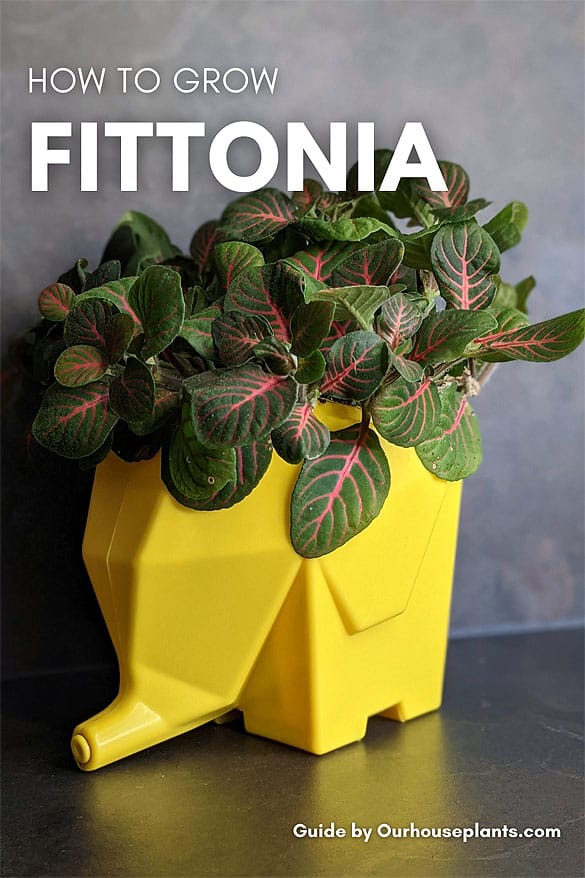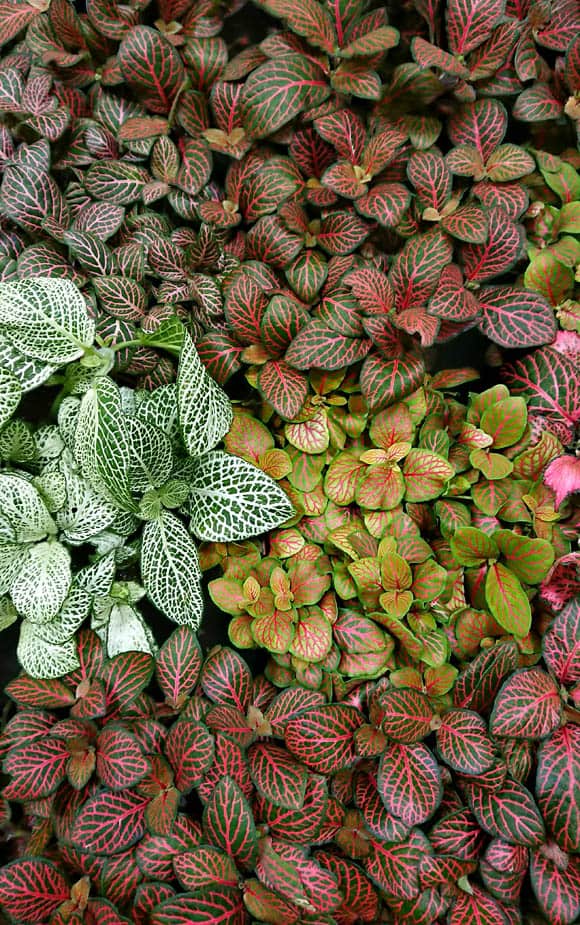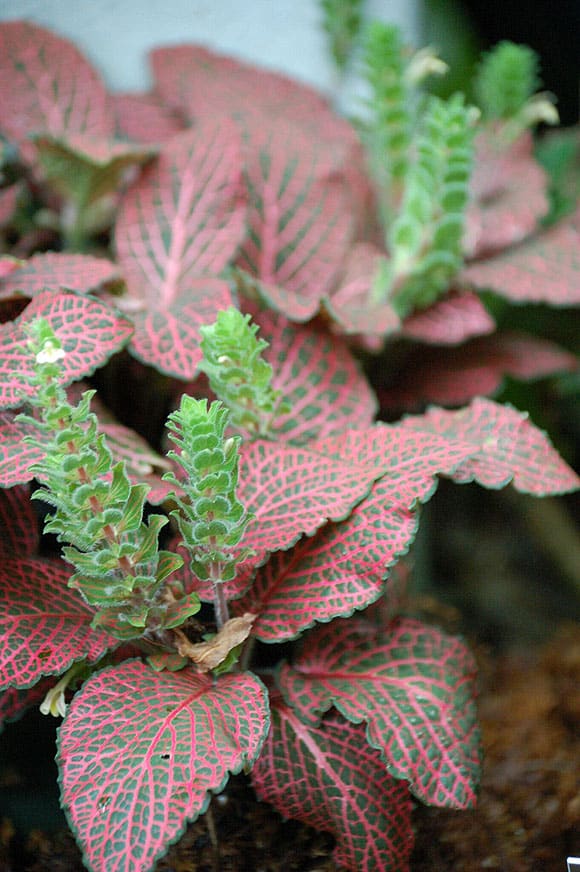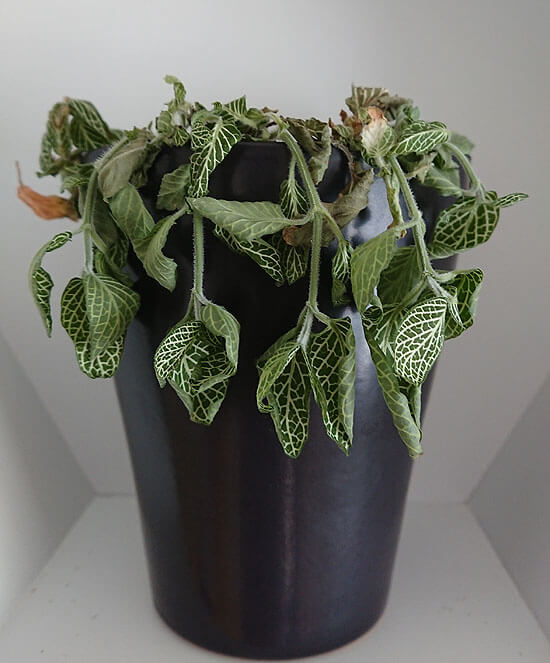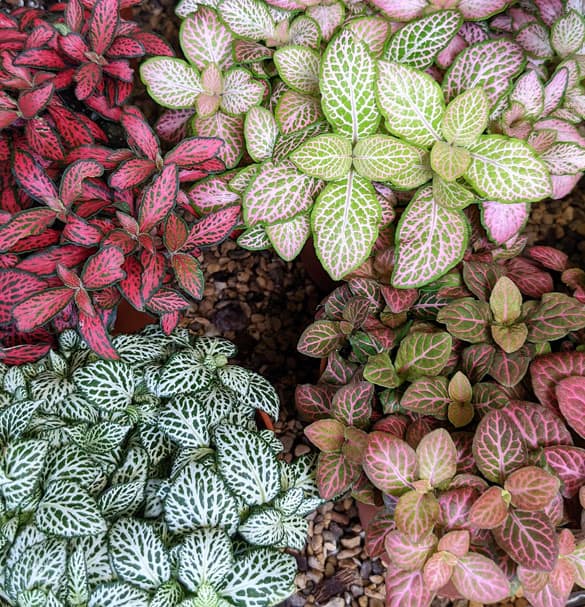The Fittonia houseplant also goes by the common names of Mosaic Plant or Nerve Plant because of the striking colors of the veins that run through each egg-shaped leaf. The traditional varieties have white veins, but many new cultivars have different colors to pick from.
If well looked after, it can grow fairly fast, spreading towards the edge of its pot, with stray runners making ideal candidates for propagation. It may produce short lived flowers from time to time, but the beautiful foliage will provide you with a splash of interest and last throughout its entire lifetime.
The Nerve Plant with its dark green leaves and attractive colored veins is an easy to grow houseplant and this article will tell you all you need to know.
The plant is native to tropical rainforests in South America, growing in high humidity, dappled shade and moist, fertile soil. Not surprisingly, this makes them fantastic additions for bottle gardens and terrariums.
Forgiving some neglect and being perfectly adapted to cope with lower light levels found in most homes makes an easy houseplant that will thrive indoors.
How do you pronounce Fittonia correctly? Say:
Fit-Toe-Nee-uh
Fun fact. The Fittonia Genus is named after Sarah Fitton and Elizabeth Fitton, botanists living in the 19th century. Their work helped make botany, as a field of scientific study, more popular for women.
While many cultivars exist, they all have some type of extreme contrasting or eye-catching veining on the egg-shaped leaves. If you like the look of the Jewel Orchid but want something more compact and shorter, you'll love the Nerve Plant as it doesn't grow tall at all and won't outgrow its pot quickly.
There are quite a few Fittonia albivenis varieties and cultivars available to buy. Actually, that's an understatement. There are in fact, loads! The choice on offer is so huge a regular nursery might only have the space to stock a few.
Plants for sale will generally be fair-sized and at a mid to low price range. They don't grow very tall so whatever you pick up from a store is likely only to spread out rather than get taller. This makes them a great pick because you can get something cheap(ish) that's already fully grown.
You might even find very young plants in tiny pots and these should be cheaper still if you don't mind growing them on to maturity.
Fittonia plants can have lots of different leaf markings - all have similar care, so all you need to do is pick your favorite.
As mentioned the variety on offer is immense. So much so we don't have the space to list all you can buy. We will quickly list some of the most popular ones you'll come across.
If you're after really striking and vivid plants with green leaves and blood red veins look out for "Fortissimo", and "Red Anne". "Albivenis Mosaic" and "Skeleton" also have red veins, but the leaves are a lighter green so the contrast is more natural.
What variety do I have?
With so many available, it can be tricky to identify what you have. If the seller hasn't provided its name, we've linked to a YouTube video just below that runs through 20 different plants. Be sure to check it out.
If you're after pink hues then "Mosacis Pink Diamond", "Pink Crinkle" and "Pink Star" with pink veins are all excellent picks and fairly common wherever Nerve Plants are sold. "Pink Angel" is a nice choice. It's a lot less common so you may have to search it out. The pink is toned down a little and the leaves have a maroon hue which goes well together.
If you're more of a traditionalist and find the above mentions to "Alien" looking, the familiar green and white veined plants are probably more to your taste. "Mini Superba", "White Forest Flame" and "Snow Anne" should all fit this criteria.
If you want to see Fittonia varieties with names and pictures check out this YouTube video that will show you 20 different plants in a visual slideshow.
20 Beautiful Fittonia Varieties by Decor & Beauty photo still

Hi, I'm Tom!
If you're like me and enjoy the challenge of growing houseplants and getting them to thrive, then Ourhouseplants can help. This website shares my knowledge and years of growing plants and provides (hopefully) helpful advice on properly caring for your indoor plant friends.
Fittonia plants are well adapted to lower light levels and so don't mind being set back from a window. They aren't truly "low light" plants and so if you're attempting to grow them in a really shady spot, you may notice some of the markings fading and becoming less vivid over time.
If the markings fade, your plant's not growing or it looks quite spindly and lanky, try and move them to a slighter brighter place that gets medium light. Either way, avoid direct sunlight as they can quickly burn and develop crispy leaves.
Part of the reason they do well in bottle gardens and terrariums is that they love a relatively constant damp growing medium. Don't read this as "soggy" or wet. They're not bog plants, so they need a mix of moisture and air around the roots. If you press the soil and water drips out, it's too wet.
Watering Expectations
Their water needs will depend on the light, temperature and time of year. During summer, plants in sunny, warm locations will need a lot more water than those growing in low-light and cooler spots.
As a rough guide most plants will likely need watering once or twice a week. Less in winter when growth slows down.
When they urgently need water they're very "showy" and overly dramatic. Throwing themselves over the side of whatever container they're growing in and looking pretty unhealthy and sorry for themselves. You'll definitely spot the call for attention when they do this.
A splash of water and within a few hours it will perk right up again. Some guides say not to allow this to happen, but it does occur with regular frequency with my plants, and I've not seen any long-term damage. Leaving them in this state for days is not a good idea, but the occasional "flop" is unlikely to cause lasting harm.
Nerve Plants are tropical plants growing on the rainforest floor meaning they do indeed like higher humidity levels. Although due to its adaptable nature unless you have very dry air in your home or workplace, this plant should still get by with whatever it's given.
Let's assume you do have low humidity, what can you do to help? A great way to provide more humid conditions is to use a room humidifier, especially if you already have many tropical houseplants. If you don't want one of these you can consider regular misting which will help create a humid environment.
A well balanced plant food every few months will help your plant to stay healthy and better ward off any pests or diseases. Regular feeding will also help keep the leaf markings vivid and striking.
They're not heavy feeders though, so you can dilute the fertiliser to half strength and still get outstanding results.
You've probably guessed this already, but they do enjoy warmer temperatures over cooler ones because they come from tropical countries. The ideal range you want to try and grow it in is somewhere between 15°C (60°F) and 23°C (75°F).
Nerve Plants rarely need repotting. You'll mainly do it for one of the following reasons:
Out in their native habitat they grow in moist humus-rich soils surrounded by organic matter. As houseplants, the best fit will be peaty mixes which easily hold moisture. Regular potting compost or soil sold by most garden supplies therefore is perfect.
A note of caution though. Peat moss is not realistically a sustainable resource and many gardeners, both indoors and out, are concerned about its use. Governments are also making progress in phasing out it's use entirely. Rightly so, as mass harvesting is incredibly damaging to the environment.
Wherever possible, we recommend avoiding peat-containing products or at the very least buying peat-reduced blends. This is a growing industry worldwide, so products like this might be harder to come by or slightly more expensive. But it's essential to support it wherever possible as this will eventually lower the prices for all and encourage innovation for new and even better performing mixes.
The most reliable way you can propagate new plants is to divide a large and congested one. Very gently remove them from their container and you can break the "clump" apart. Each section can become its own separate plant and a largish Fittonia could give you three or four new ones.
In the late Spring and summer months, you could also try stem cuttings cut off a few stems, making sure each one has just a few leaves. Then pot up into a similar potting mix it was growing in previously. Keep warm and the soil just moist and new roots should form. A rooting hormone like this one on Amazon* will increase your chances of the cutting taking.
*Our website is free because readers like you support it. Thank you. We'll sometimes earn a small commission when you buy something through the affiliate links on our site like the one above.
In general, I've not found Fittonias to be super fast growers. But because they're pretty small plants and close to the ground, just a few new leaves will make it look quite different.
Each variety has slightly different growth styles, but broadly speaking, few will ever get taller than 15cm (6in).
Growing Tip - You choose the look.
Use the plant's spreading trait to grow far-reaching, broad plants. Alternatively, keep them in narrow pots to keep them neat and compact.
They can spread though! Once they reach the edge of the container, that's it. You'll get no more growth. But if the container allows it, the plant will keep growing outwards until it reaches the sides of the pot.
Fittonia is almost always brought because of the foliage. Although flowers can be produced occasionally, they're not very impressive compared to the varied and eye-catching leaves.
Not a common sight, but the Fittonia will sometimes flower like this indoors - Photo by Qabluna
You won't need to worry about these plants around your pets because they're nontoxic.
Most Fittonias have a compact and bushy habit by default. If your plant is starting to "reach" or spread apart a few things to consider to help bring it back in line.
Collapsed and badly wilted Fittonia plant
One of the common, if not the most common issue Nerve Plant owners will come across is the dramatic "flop" which looks something like what's shown in the photo below.
Such dramatic and over the top plants. This might look really bad, but a splash of water and it will look like new.
It's not a big issue. A drop of water and it will perk up within a few hours. It's a strong warning sign of underwatering though so try not to let it do this too often.
Yellow Leaves
Usually, this is a early warning sign of overwatering. They love moisture for sure, but all they need is damp soil for this. Anything borderline saturated and soggy is too much and will often cause yellowing leaves.
Be very careful if you're using pots or containers without drainage holes which will trap excess water around the roots. Poor drainage is one of the most common reasons they won't last.
Ignore the yellowing and pretty soon you'll get root rot. When it gets to this stage your plant will collapse so try to get your watering technique down early on. Read this if you need a refresher.
Leaves losing color / markings
The Fittonia will deal with quite low light levels, but the markings can fade if it's really dark. Move it to a place that's a little brighter and the markings should develop again.
Crispy dried and brown leaves
Crispy brown leaves are all symptoms of either too much light (normally direct sunlight) or very low humidity. You will need to move it somewhere less bright and ideally more humid.
Pests
None of my plants have ever had issues with pests so I feel they're pretty resistant. If something is bugging yours though (groan!), have a look at our Pest Guide to help identify and resolve the problem and prevent any ant-ticks (yes, I did just deliver two pun jokes in one paragraph).
Cards on the table. This houseplant is a little boring to me. It stays low to the ground, grows slowly and seems a little "frilly" for my tastes. #harsh
If you've already read this far chances are you actually quite like this plant. So let me explain my thoughts a bit more. Regular readers will already know that I love more unusual or structural plants that add definition, where as this is much more dainty. It also doesn't help that my Nan grew these when I was growing up, so it does have an "old lady" feel for me.
Cards on the table. This houseplant is a little boring to me...
Don't get me wrong, I'm not saying this is a bad plant to have and without doubt it has it fans and some significant advantages over similar plants that are brought for their vivid and striking foliage.
For example Coleus will grow out of control if it's not frequently pruned and Croton's need good light levels to retain their markings. Whereas Fittonias will stay nice and compact and do well in lower light all year round providing you provide the right growing conditions.
So even though it's not my favorite houseplant of all time, its advantages and what it can bring to a home where houseplants are an important part of the decor are undeniable. So of course I own a couple.
They can add high levels of texture and visual interest to very straight and angled areas of your home. I grow one of mine in a geometric yellow elephant container (first photo at the top of the article), of course it's contrasting and not to everyone's style, but it adds a huge visual splash right where it's needed.
Four different varieties of nerve plant - If you can give them plenty of humidity, avoid soggy soil and too much sunlight, they'll all do well in your home for many years.
No matter your tastes with so many different varieties to pick from, I'm sure there is a Fittonia for every home. Do you display yours for dramatic visual interest, or perhaps you under plant it under something taller, Terrarium grower? Tell me, I'd love to learn more about how people use and grow these plants.
(Article / Gallery) Photo credit of the Fittonia houseplant in flower by Qabluna
